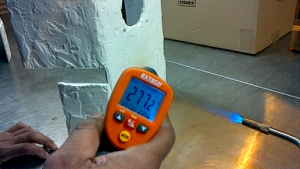 In contrast to the previous post about using insulating coatings for ambient and cold temperatures, I would like to share my direct research on the use of ceramic coatings for high temperature applications.
In contrast to the previous post about using insulating coatings for ambient and cold temperatures, I would like to share my direct research on the use of ceramic coatings for high temperature applications.
I received a piece of metal with a 1/4″ think layer of ceramic coating, This is at least 10 times thicker than any of the manufacturer recommended thickness applications provided for our sea container cabin project. The origin of the coating was not confirmed, however we believe it is a SuperTherm product. We jumped straight into the high temperature test using the ceramic coated metal, a torch and an infrared temperature gun and videotaped the results to share with you.
This video speaks for itself.
Suffice it to say, I am convinced that ceramic coatings do have amazing performance characteristics in high temperature and high delta T applications that would be great for high temperature applications.
